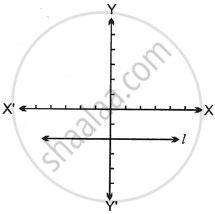Advertisements
Advertisements
प्रश्न
If A(6, 1), B(8, 2), C(9, 4) and D(7, 3) are the vertices of `square`ABCD, show that `square`ABCD is a parallelogram.
Solution:
Slope of line = `("y"_2 - "y"_1)/("x"_2 - "x"_1)`
∴ Slope of line AB = `(2 - 1)/(8 - 6) = square` .......(i)
∴ Slope of line BC = `(4 - 2)/(9 - 8) = square` .....(ii)
∴ Slope of line CD = `(3 - 4)/(7 - 9) = square` .....(iii)
∴ Slope of line DA = `(3 - 1)/(7 - 6) = square` .....(iv)
∴ Slope of line AB = `square` ......[From (i) and (iii)]
∴ line AB || line CD
∴ Slope of line BC = `square` ......[From (ii) and (iv)]
∴ line BC || line DA
Both the pairs of opposite sides of the quadrilateral are parallel.
∴ `square`ABCD is a parallelogram.
उत्तर
Slope of line = `("y"_2 - "y"_1)/("x"_2 - "x"_1)`
∴ Slope of line AB = `(2 - 1)/(8 - 6) = 1/2` .......(i)
∴ Slope of line BC = `(4 - 2)/(9 - 8) = 2` .....(ii)
∴ Slope of line CD = `(3 - 4)/(7 - 9) = 1/2` .....(iii)
∴ Slope of line DA = `(3 - 1)/(7 - 6) = 2` .....(iv)
∴ Slope of line AB = Slope of line CD ......[From (i) and (iii)]
∴ line AB || line CD
∴ Slope of line BC = Slope of line DA ......[From (ii) and (iv)]
∴ line BC || line DA
Both the pairs of opposite sides of the quadrilateral are parallel.
∴ `square`ABCD is a parallelogram.
APPEARS IN
संबंधित प्रश्न
A slope of a line is 3 and y-intercept is –4. Write the equation of a line
The line passing through (−4, −2) and (2, −3) is perpendicular to the line passing through (a, 5) and (2, −1). Find a.
Find the value(s) of k so that PQ will be parallel to RS. Given : P(2, 4), Q(3, 6), R(8, 1) and S(10, k)
Find the slope of the line which is perpendicular to `x - y/2 + 3 = 0`
Lines 2x – by + 5 = 0 and ax + 3y = 2 are parallel to each other. Find the relation connecting a and b.
Angles made by the line with the positive direction of X–axis is given. Find the slope of these line.
60°
Angles made by the line with the positive direction of X–axis is given. Find the slope of these line.
90°
Find the slope of the lines passing through the given point.
P (–3, 1) , Q (5, –2)
Fill in the blank using correct alternative.
A line makes an angle of 30° with the positive direction of X– axis. So the slope of the line is ______.
Find k if the line passing through points P(–12, –3) and Q(4, k) has slope \[\frac{1}{2}\].
Find the slope of a line, correct of two decimals, whose inclination is 45°
Find the slope of a line passing through the given pair of points (3,7) and (5,13)
Find the slope of a line parallel to the given line 5x + 2y = 11
Find the value of a line perpendicular to the given line 5x+2y-9 = 0
Find the slope and the y-intercept of the following line x - 2 = `(5 - 3"y")/2`
Find the slope of the line passing through the points M(4,0) and N(-2,-3).
Find the value of x so that the line passing through (3, 4) and (x, 5) makes an angle 135° with positive direction of X-axis.
In the figure, line l is parallel to X-axis. Which of the following statement is true?

If the lines kx – y + 4 = 0 and 2y = 6x + 7 are perpendicular to each other, find the value of k.
